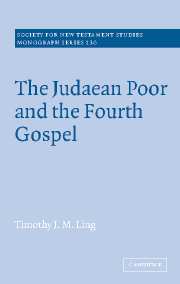4 - The Judaean ‘poor’
Published online by Cambridge University Press: 22 September 2009
Summary
Introduction
The preceding chapter's discussion of a first-century Judaea permeated by forms of ‘virtuoso religion’ which potentially offered cultural resources that radically addressed the ‘poor’, i.e. a piety of poverty, is clearly of heuristic significance for understanding the New Testament's poor. It is also clear from recent ‘social approaches’ to the ‘poor’ surveyed in this chapter that a more nuanced social-scientific view of the ‘poor’ is desirable. Indeed, this survey of recent approaches reveals a paradoxical disregard for the social location of the ‘poor’ in favour of crude intra-textual analysis of formulaic motifs concerning the ‘blind, the lame and the poor …’. In contrast to these approaches, this chapter re-presents the social world of the New Testament's ‘poor’, and revisits the earlier social approaches' intra-textual analyses. It argues that, rather than being suitable material for such analysis, these texts illustrate the contested nature of their subjects, which include the ‘poor’. In this context an excursus on the first makarism is presented, which argues against QLk's priority. Furthermore, beyond the formulaic motifs, the ‘poor’ in the earliest traditions are also examined and two apparently interrelated themes revealed: an association between the ‘poor’ and piety, and a Judaean focus, or location, for these traditions. This Judaean context is further underlined in the references to the ‘poor’ as recipients of alms. Throughout this re-presentation of the ‘poor’ in the New Testament world, the insights gained from a more integrated view of religious social actors within their social worlds, facilitated by the social-scientific material on the ‘religious virtuoso’, prove highly illuminating.
- Type
- Chapter
- Information
- The Judaean Poor and the Fourth Gospel , pp. 98 - 145Publisher: Cambridge University PressPrint publication year: 2006



